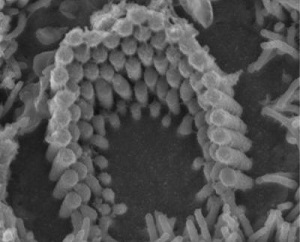Our ability to hear relies on hair cells, sensory receptors that mechanically amplify low-level sound that enters the inner ear through a transduction channel. Although the transduction channel was characterized more than 30 years ago, researchers have been unable to identify its molecular components. A new study in The Journal of General Physiology could help lead to a definitive identification of this mystery channel.
Recent studies have suggested that members of the TMC family of membrane proteins are strong candidates as the components of the hair cell's transduction channel. Now, a team led by scientists from the University of Wisconsin Medical School provides evidence that the TMCs instead couple the transduction channel to tip links—the mechanical elements that provide directional sensitivity to hair cells—and are not the channel itself. This suggests that the transduction channel may be a membrane protein distinct from TMCs that only functions properly once other key molecules are expressed.

A study in The Journal of General Physiology provides new evidence about the molecular makeup of the hair cell transduction channel, which plays a critical role in our ability to hear (magnified region of a hair cell shown here). Credit: Kim et al., 2013
Whether or not TMCs turn out to be the transduction channel, the new results affirm that they play a central role in hair cell mechanotransduction. The work adds to evolving research aimed at understanding the cellular and molecular mechanisms that affect hearing.
About The Journal of General Physiology
Founded in 1918, The Journal of General Physiology (JGP) is published by The Rockefeller University Press. All editorial decisions on manuscripts submitted are made by active scientists in conjunction with our in-house scientific editor. JGP content is posted to PubMed Central, where it is available to the public for free six months after publication. Authors retain copyright of their published works and third parties may reuse the content for non-commercial purposes under a creative commons license. For more information, please visit https://jgp.rupress.org/.
Research reported in this press release was supported by the National Institutes on Deafness and other Communication Disorders (NIDCD) of the National Institutes of Health under award number RO1DC01362. The content is solely the responsibility of the authors and does not necessarily represent the official views of the National Institutes of Health.
Barr-Gillespie, P.G., and T. Nicolson. 2013. J. Gen. Physiol doi:10.1085/jgp.201311111 Kim, K.X., et al. 2013. J. Gen. Physiol. doi:10.1085/jgp.201311068
Source: https://www.eurekalert.org/pub_releases/2013-10/rup-iam102413.php

